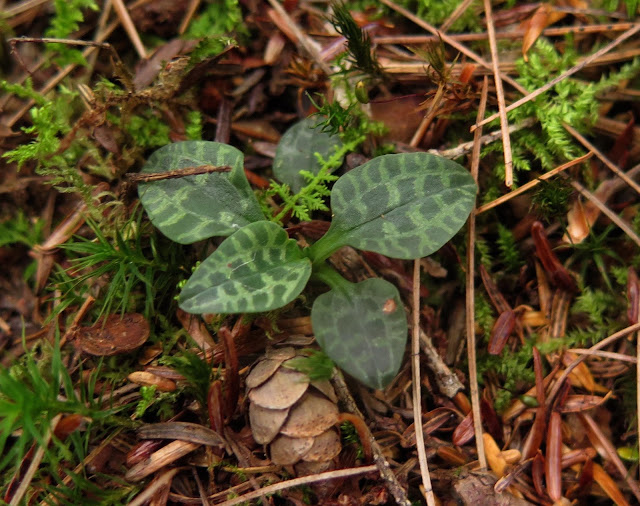Hey! It's fall! This is supposed to be the height of mushroom season. But where are they, our fungal friends? I've explored many of my usual haunts these past weeks and found almost nothing. Maybe a few shriveled remnants here or there, but not the glorious profusion of mushrooms in astounding varieties of shapes and colors I usually find each fall. Just too hot and dry, I guess. But driven by hopes, my friends Sue and Ruth joined me last week to head 40 miles north to the Pack Demonstration Forest in Warren County, recalling the abundance of fungi we've found there in past years. But nope, not this year. Ah well, at least we enjoyed some other fascinating finds. Here's just a sampling.
Never in my life have I seen a Tamarack tree so huge. But here this one was, towering over all other trees right near the parking lot and turning the lovely golden color it grows just before its needles drop. American Larch is another name for the Tamarack (Larix laricina), our only conifer that loses its needles every fall. I suppose I should not have been surprised to find such a giant tree at this site, since the Pack Demonstration Forest is home to some of the largest old-growth trees in New York. Notably, White Pines, though, not Tamaracks.
Instead of following the Nature Trail into the old-growth White Pine forest as we usually do, we took a road that led us to the Pack Forest Lake. Alerted by the haunting call of a Common Loon, we stood on the shore watching the lake, and we soon caught sight of a solitary loon, still in juvenile plumage, swimming across the still water, occasionally diving out of view. A quintessential Adirondack experience! This young loon's parents probably left to winter on the Atlantic already, and the juveniles will soon follow, hopefully before the lake freezes over. A loon cannot take flight unless it has a long stretch of open water to take off from.
Deprived of fungal finds, we nevertheless enjoyed searching the forested roadside for whatever there was to see, grateful to have our friend Ruth's ever-more-expert knowledge of mosses available to inform us about what we found. But in many ways, with these two pals along, I always have great fun in the woods, no matter how scarce the woodsy attractions.
A huge patch of Scouring Rush (Equisetum hyemale) filled a damp roadside ditch with its strictly erect jointed and leafless stalks, each stalk crowned with an elaborate strobilus (spore-bearing cone) as ornate as any Ukrainian Easter egg. Sharing the same ditch and intermingling with the Scouring Rush was a much more slender Equisetum species that I at first assumed was an immature version of the Scouring Rush. But I have since learned that this slender version is a species in its own right, called Equisetum variegatum (Variegated Scouring Rush).
A true highlight of our walk at Pack Forest had less to do with the plants we found, although it did have to do with fellow nature lovers: a chance meeting on the trail with a couple of folks named John and Louise. As we encountered one another and stopped to happily chat and compare trailside experiences, John suddenly recognized me as the author of this blog, and burst forth with so many enthusiastic comments about it I could hardly believe my ears. John, I want you to know how much your words have meant to me! Sometimes I feel I have said all I have to say about our regional woods and waters, and I think about putting this (nearly 14-year-old!) baby to bed. Of course, I then have an experience I can't wait to share with my fellow nature enthusiasts, and so I continue posting, although perhaps a bit less often than before. But even more encouraging to me is knowing there are readers still out there who not only follow my blog, but who also head into the woods or out on the waterways, inspired (so they tell me) by what I share here. And then go on to inspire others to care for our natural world. Lord knows, our poor suffering planet needs all the defenders it can get.









1 comment:
Please,o please don't stop posting. My knowledge of mosses and liverworts is extremely limited and your posts have been a real help; not to mention all the plants I've never seen.
Post a Comment